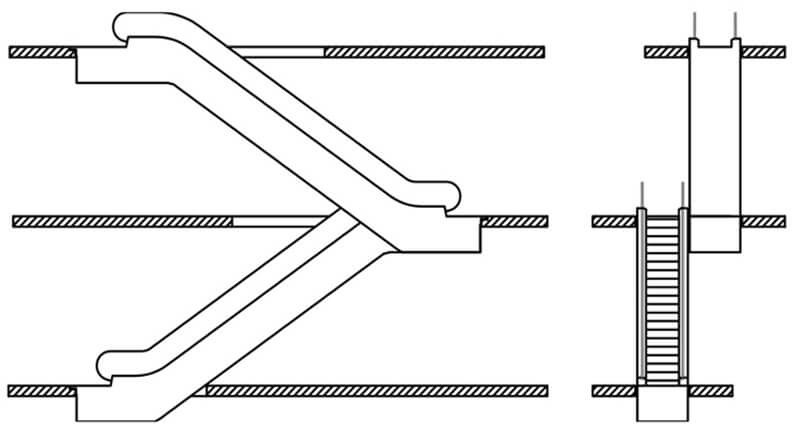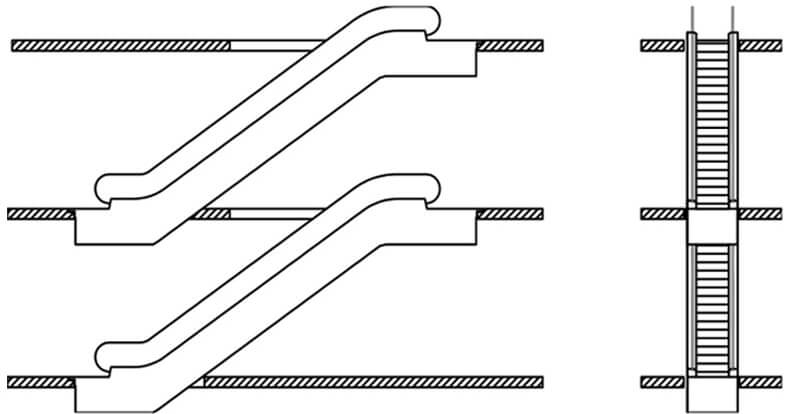Arrangement of Escalators and Moving Walkways
Single unit arrangement
Single link between two levels with one traffic direction. Change of direction depending
on traffic flow possible. It is preferred in buildings where the main density of building traffic is concentrated in one direction. It is possible to adjust the direction of movement. For example, up in the morning, down in the evening.
Continuous arrangement
(one travel direction)
It is convenient for the passengers, but enough space is required and mainly used in small
department stores. It is the preferred layout in small shopping centers. More clarity is needed than the discrete layout.
Interrupted arrangement
(one travel direction)
Since customers attention can be attracted on the small detours, a bit inconvenient for
the passengers, but less space consuming and favorable for department store owners. Although it is seen as uncomfortable for users, it is an advantageous layout for stores. When users go up two floors, they also tour around on the floor in between.
Parallel, interrupted arrangement
(two-way traffic)
Since no lateral claddings are required, it can be economically installed and since customers
attention can be attracted on the small detours, it is favorable for department store owners. It is preferred in places with heavy passenger traffic such as large shopping malls, airports, train and metro stations. If there are more than two units next to each other, these units can be operated in the desired direction according to the density. In addition, it is economically advantageous as it does not use the coatings on the common sides of the units.
Crisscross, continuous arrangement
(two-way traffic)
Suitable for a minimum transportation time and highest capacity. Mainly used in major
department stores, public buildings and public transportation areas. It is preferred in places such as big shopping malls, airports, train and metro stations where passenger traffic is heavy to prevent the accumulation of passenger density in the same areas.
Single link between two levels with one traffic direction. Change of direction depending on traffic flow possible. It is preferred in buildings where the main density of building traffic is concentrated in one direction. It is possible to adjust the direction of movement. For example, up in the morning, down in the evening.
(one travel direction)
It is convenient for the passengers, but enough space is required and mainly used in small department stores. It is the preferred layout in small shopping centers. More clarity is needed than the discrete layout.
Interrupted arrangement
(one travel direction)
Since customers attention can be attracted on the small detours, a bit inconvenient for
the passengers, but less space consuming and favorable for department store owners. Although it is seen as uncomfortable for users, it is an advantageous layout for stores. When users go up two floors, they also tour around on the floor in between.
Parallel, interrupted arrangement
(two-way traffic)
Since no lateral claddings are required, it can be economically installed and since customers
attention can be attracted on the small detours, it is favorable for department store owners. It is preferred in places with heavy passenger traffic such as large shopping malls, airports, train and metro stations. If there are more than two units next to each other, these units can be operated in the desired direction according to the density. In addition, it is economically advantageous as it does not use the coatings on the common sides of the units.
Crisscross, continuous arrangement
(two-way traffic)
Suitable for a minimum transportation time and highest capacity. Mainly used in major
department stores, public buildings and public transportation areas. It is preferred in places such as big shopping malls, airports, train and metro stations where passenger traffic is heavy to prevent the accumulation of passenger density in the same areas.
Since customers attention can be attracted on the small detours, a bit inconvenient for the passengers, but less space consuming and favorable for department store owners. Although it is seen as uncomfortable for users, it is an advantageous layout for stores. When users go up two floors, they also tour around on the floor in between.
(two-way traffic)
Since no lateral claddings are required, it can be economically installed and since customers attention can be attracted on the small detours, it is favorable for department store owners. It is preferred in places with heavy passenger traffic such as large shopping malls, airports, train and metro stations. If there are more than two units next to each other, these units can be operated in the desired direction according to the density. In addition, it is economically advantageous as it does not use the coatings on the common sides of the units.
Crisscross, continuous arrangement
(two-way traffic)
Suitable for a minimum transportation time and highest capacity. Mainly used in major
department stores, public buildings and public transportation areas. It is preferred in places such as big shopping malls, airports, train and metro stations where passenger traffic is heavy to prevent the accumulation of passenger density in the same areas.
Suitable for a minimum transportation time and highest capacity. Mainly used in major department stores, public buildings and public transportation areas. It is preferred in places such as big shopping malls, airports, train and metro stations where passenger traffic is heavy to prevent the accumulation of passenger density in the same areas.




